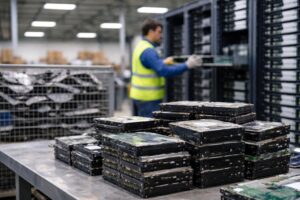Most teams don’t talk about electrification thresholds until they’ve already hit them. They’re not on any plan or checklist. You notice them in the middle of a job when heat stops rising like it should, when the material starts behaving oddly, or when energy loads don’t settle the way the model said they would. That’s how it plays out in high-heat industrial processes. The limits show up early, and they don’t give much warning.
Still, plenty of projects move ahead without catching the signs. Electric systems are clean, yes, and they scale well, but they don’t always work the way high-temperature processes need them to. And in nonstop operations, or where moisture’s in the mix, things go sideways fast and expensively.
This isn’t a pro-or-con article. It’s about knowing where things start to break down. That line matters more than people think. Because beyond that point, no matter how good the tech looks on paper, returns drop hard. So, let’s dive in.
What Makes High-Heat Industrial Processes Uniquely Hard to Electrify
Heat above 400°C behaves with tighter margins and faster consequences. Systems running at these levels demand more than just power; they demand precision, recovery speed, and thermal behavior that not all electric solutions can deliver. This section breaks down where the real frictions begin and why they matter far earlier than most plans assume:
Latent Heat Demands That Outpace Electric Heating Rates
Delivering surface heat is one thing; sustaining deep thermal load during moisture extraction or phase change is another entirely. In high-heat industrial processes, drying, evaporating, or thermally transforming materials requires momentum, sharp heat pushed sustained across time. Electric panels may hit target temperatures, but they falter when the process needs internal absorption at pace.
And when the heat drops mid-cycle? The penalty isn’t small. Electric systems recover slowly, often forcing the process to stall or lag behind production rhythm. Oversizing helps, but only to a point—efficiency crashes quickly. That’s where clear electrification thresholds surface: when the heat input no longer matches the urgency of internal demand.
Material Integrity Issues at Transition Points
Not all materials adapt well when exposed to different conditions. Many processes rely on fast, uneven exposure to trigger chemical or structural changes, surface curing, internal bonding, and rapid expansion. Switch to electric systems, and the whole thermal signature shifts. Instead of a radiant spike, you get smooth conduction; instead of layered intensity, you get flat distribution.
This subtle change rewires the entire response of metals, ceramics, composites, or powders mid-cycle. What once cured now cracks; what held firm now softens. In some settings, the process doesn’t just lose quality; it collapses. That breakdown isn’t about inefficiency. It marks a fundamental electrification threshold driven by the way heat interacts with matter itself.
Heat Transfer Mode Conflicts Between Flame-Based and Electric Systems
Every process has an unspoken expectation: how heat should move. Flame-based systems operate with chaotic but high-energy transfer—convection and radiation dominate, hitting surfaces unevenly but with force. Electric systems tend to do the opposite. They favor consistent, linear conduction; they reduce variance but also blunt impact.
When processes expect turbulence or radiant spikes, this shift becomes a liability. Coatings dry late, surfaces respond more slowly, airflow loses its edge, and suddenly, the process falls out of spec. Engineers attempt to recalibrate, but the mismatch lives inside the system’s architecture. That moment, when process demands no longer match the thermal style delivered, defines one of the hidden but critical electrification thresholds.
Uninterruptible Thermal Cycles That Penalize Downtime
Some thermal cycles have no margin for interruption. When heat must stay constant, minute by minute, stage by stage, any delay creates a failure cascade. In glass tempering, forging, or composite curing, a single pause forces reprocessing or total scrap. That’s where combustion has long thrived: it rebounds instantly, delivering full thermal load with zero delay.
Electric systems, on the other hand, ramp slowly; they require sequence controls, and they penalize restarts with time and energy draw. During shift changes or unexpected halts, the delay can cost entire batches. At this point, the issue isn’t heating power; it’s thermal continuity. The break in the flow exposes a non-negotiable electrification threshold tied directly to operational uptime.
Thresholds Where Electrification Stops Making Economic Sense
Some electrification efforts don’t fail because the equipment is wrong; they fail because the math turns on them. Thermal intensity alters not just the system load, but also its financial behavior. Above a certain threshold, price curves bend backward. This section identifies the electrification thresholds where cost, infrastructure, and return on investment begin to diverge:
Exponential Cost Rise Above 600°C for Retrofitted Electric Systems
Electric heating can perform well under 500°C, but once systems cross 600°C, the cost increases accelerate. Every degree added raises insulation demand, shortens component lifespan, and forces higher-spec materials across the board. Unlike gas systems, which scale linearly, electric retrofits hit nonlinear cost curves fast.
Even so, many teams underestimate these escalations. In high-heat industrial processes, the shift from manageable upgrade to full redesign often happens mid-project. That’s where budgets spiral. At this point, you’re no longer investing in efficiency; you’re spending just to survive process integrity. This marks one of the electrification thresholds few forecast until the capital’s already gone.
Peak Load Penalties That Distort Monthly Energy Spend
Electricity billing punishes consistency at scale. When systems operate at continuous high power, peak demand charges activate, even if total usage remains stable. As a result, companies get billed not for what they consume, but for when and how they consume it.
These charges sneak in silently. Many teams calculate energy savings, yet forget to model tariff structures. That’s when savings erode. Grid-tied plants see their energy spend balloon even as efficiency improves. Ultimately, the cost of industrial electrification doesn’t just reflect usage; it reflects grid logic. If this logic isn’t favorable, electrification stops making sense fast.
Redundancy Demands That Double Infrastructure Investment
In high-uptime environments, one power source isn’t enough. Processes requiring constant heat can’t afford failure, not even for minutes. Gas systems recover instantly; electric setups do not. To compensate, engineers add failover layers, backup panels, and load-sharing architecture.
This added reliability comes at a steep price. Facilities often find themselves duplicating major systems just to maintain uptime. In doing so, they double their capex. While this redundancy avoids risk, it introduces a new limit. Eventually, cost outpaces value. At this point, you’re staring at another one of the electrification thresholds, not because the system broke, but because the business model did.
Cooling Loads That Cancel Out Energy Efficiency Gains
Electric heating generates significant radiant and ambient heat. That’s fine in isolated systems, but in full-scale operations, it builds fast. Consequently, cooling infrastructure works harder to stabilize internal temperatures, draining energy you just saved elsewhere.
This creates a loop. The process gets cleaner, but the plant gets hotter. Ventilation ramps up, compressors run longer, and baseline efficiency drops. What began as an emissions solution becomes an HVAC problem. In many cases, this thermal rebound signals when not to electrify industrial heat, as it offsets the original gains. That’s one of the hidden electrification thresholds—one tied to facility physics, not process performance.
Alternative Electrification Models That Avoid the Breaking Point
When direct electrification becomes too expensive or mechanically disruptive, the smart move isn’t retreat; it’s redesign. Many operators now reach energy goals by rethinking how and where electricity is applied. This section explores strategies that bypass rigid system-wide conversion and avoid crossing into unrecoverable electrification thresholds:
Segment-Based Electrification for Thermal Subzones
Full-line retrofits introduce complexity that often stalls execution. Segmenting the thermal load, electrifying preheat zones or post-process curing, cuts that complexity dramatically. Instead of one massive system, you create small, optimized electric zones that deliver maximum return with minimum risk.
This model underpins many hybrid industrial heating systems. You electrify the sections where temperature is predictable and stable while preserving combustion in high-variability zones. This avoids triggering infrastructure overhauls and keeps control tight. By targeting only what works, you delay—or eliminate—critical electrification thresholds that full-system conversions would’ve slammed into early.
Heat Storage to Flatten and Buffer Electric Load Peaks
Buffering smooths volatility. Instead of scaling electric delivery to match every surge, thermal storage systems stockpile heat during off-peak hours and release it when the process demands spike. This keeps electric systems light and avoids load penalties altogether.
This approach is increasingly viable in high-heat industrial processes where thermal consistency matters but instantaneous power delivery doesn’t. Ceramic beds, phase-change blocks, or molten salt tanks take the load off the grid and your system design. As a result, you extend the effectiveness of electrification without ever brushing against the operational electrification thresholds that would otherwise cut your plan short.
Hybrid Systems That Use Flame Only for Final-Stage Heat
Some stages just don’t convert well. Instead of forcing electrification where it breaks performance, operators now keep combustion strictly for those end-phase requirements, melting, forging, or rapid surface curing, and electrify everything else.
These are true hybrid industrial heating systems, not stopgaps. They split the load intentionally to reduce emissions and operating costs while maintaining output quality. Importantly, they sidestep the thermal density challenges that electric systems often can’t handle alone. By confining fossil fuel use to zones where electricity underperforms, plants avoid inefficient oversizing and reduce the cost of industrial electrification while pushing it further, safely.
Electrifying Preprocessing Without Forcing Full Conversion
Front-end operations such as degassing, drying, or heating raw inputs rarely demand the extreme intensity of final-stage treatment. They’re a natural fit for early-stage upgrades—especially in older plants where even minor structural changes tend to spiral.
This design strategy is especially effective for teams electrifying manufacturing operations efficiently across multiple product lines. You secure fast wins with minimal disruption, decarbonize the easiest segments first, and build proof of concept before deeper changes. Because you never cross into extreme retrofit territory, you keep budgets stable and outcomes measurable, without compromising heat quality downstream.
Strategic Decision-Making Frameworks for Electrification Scope
Electrification isn’t a single decision; it’s a series of trade-offs, each with very different outcomes. The best operators don’t electrify everything—they make sharper calls on where it actually works. The gains lie in how well you map feasibility to timing, infrastructure, and payback. This section lays out strategic frameworks that let decision-makers electrify with precision, not guesswork:
Heat Load Mapping by Duty Cycle, Not Just Temperature
You can run two systems at 600°C and get completely different results. It comes down to how long heat has to hold, how deep it needs to go, and how things like moisture and mass shift the way that heat moves. Duty cycle analysis captures this nuance; temperature alone never does.
By mapping thermal intensity over time, engineers can instantly see when not to electrify industrial heat. Long ramp-ups, moisture-heavy loads, or high-latency mass create thresholds that electric systems shouldn’t cross. This isn’t caution—it’s targeting. With duty cycles in hand, teams electrify the fast wins and sidestep the traps.
Facility-Wide Simulations That Predict Grid Strain Before It Hits
Every kilowatt has a knock-on effect. When multiple thermal systems draw power simultaneously, grid-tied facilities risk cascading overload, peak penalties, or internal instability. High-fidelity energy simulations expose this tension early, before specs go live and budgets lock.
With proper modeling, teams don’t just react; they design proactively. Simulations reveal which clusters draw too hard, which timeframes overlap, and where to buffer or stage the load. As a result, planners electrify manufacturing operations efficiently, shaping demand to match both grid capacity and internal rhythm. This eliminates surprises and prevents overinvestment in infrastructure that no one needed.
ESG-Weighted Prioritization That Aligns Retrofits With Impact
Not all emissions carry equal weight. Electrifying a low-load process in a low-visibility zone won’t move the needle. On the other hand, retrofitting a visible, high-emission system tied to ESG targets brings outsized brand and compliance value, even if the payback period stretches longer.
Using an ESG-weighted framework lets leaders prioritize smartly. The first projects generate proof, momentum, and reputational return while still progressing technical goals. In the process, facilities avoid crossing unnecessary electrification thresholds, since each decision accounts for both pressure and payoff. It’s not just engineering—it’s optics and strategy, fused.
Dynamic Payback Modeling That Matches Complexity to Return
Rigid payback targets kill smart projects. A five-year ROI sounds slow until you realize the system it replaces burns through compliance penalties, cooling loads, and hidden waste annually. Phased models fix this. Instead of calculating in isolation, teams batch quick-return upgrades with longer bets in one roadmap.
This approach supports electrifying manufacturing operations efficiently without financial distortion. When teams bundle fast-payback zones with longer-term upgrades, they unlock capital and reduce risk. It’s not just more electrification; it’s targeted, phased, and built to last.
To Sum Up
Electrification isn’t a race to replace; it’s a precision game of matching technology, load, economics, and timing. Facilities that move too fast without a strategy hit walls: cost cliffs, thermal mismatches, and reliability setbacks. But those that respect real electrification thresholds move smarter and faster in the long run.
What sets top performers apart isn’t how much they electrify, but how deliberately they do it. From simulation to sequencing, hybridization to heat mapping, the future belongs to those who electrify with discipline.
To continue this conversation live alongside manufacturers, utilities, and global energy leaders, join us at the 2nd Industrial Energy Management Summit on 8–9 October 2025 in Berlin, Germany. You’ll see the strategies, numbers, and solutions that are already working. Let’s build the roadmap where industrial energy finally makes sense.




